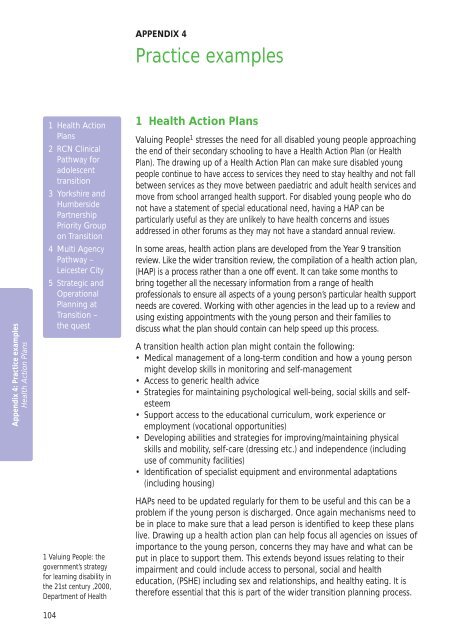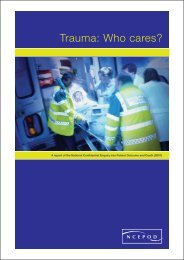A Transition Guide for All Services - Transition Information Network
A Transition Guide for All Services - Transition Information Network
A Transition Guide for All Services - Transition Information Network
- No tags were found...
Create successful ePaper yourself
Turn your PDF publications into a flip-book with our unique Google optimized e-Paper software.
APPENDIX 4Practice examplesAppendix 4: Practice examplesHealth Action PlansAppendix 41 Health ActionPlans2 RCN ClinicalPathway <strong>for</strong>adolescenttransition3 Yorkshire andHumbersidePartnershipPriority Groupon <strong>Transition</strong>4 Multi AgencyPathway –Leicester City5 Strategic andOperationalPlanning at<strong>Transition</strong> –the quest1 Valuing People: thegovernment’s strategy<strong>for</strong> learning disability inthe 21st century ,2000,Department of Health1041 Health Action PlansValuing People 1 stresses the need <strong>for</strong> all disabled young people approachingthe end of their secondary schooling to have a Health Action Plan (or HealthPlan). The drawing up of a Health Action Plan can make sure disabled youngpeople continue to have access to services they need to stay healthy and not fallbetween services as they move between paediatric and adult health services andmove from school arranged health support. For disabled young people who donot have a statement of special educational need, having a HAP can beparticularly useful as they are unlikely to have health concerns and issuesaddressed in other <strong>for</strong>ums as they may not have a standard annual review.In some areas, health action plans are developed from the Year 9 transitionreview. Like the wider transition review, the compilation of a health action plan,(HAP) is a process rather than a one off event. It can take some months tobring together all the necessary in<strong>for</strong>mation from a range of healthprofessionals to ensure all aspects of a young person’s particular health supportneeds are covered. Working with other agencies in the lead up to a review andusing existing appointments with the young person and their families todiscuss what the plan should contain can help speed up this process.A transition health action plan might contain the following:• Medical management of a long-term condition and how a young personmight develop skills in monitoring and self-management• Access to generic health advice• Strategies <strong>for</strong> maintaining psychological well-being, social skills and selfesteem• Support access to the educational curriculum, work experience oremployment (vocational opportunities)• Developing abilities and strategies <strong>for</strong> improving/maintaining physicalskills and mobility, self-care (dressing etc.) and independence (includinguse of community facilities)• Identification of specialist equipment and environmental adaptations(including housing)HAPs need to be updated regularly <strong>for</strong> them to be useful and this can be aproblem if the young person is discharged. Once again mechanisms need tobe in place to make sure that a lead person is identified to keep these planslive. Drawing up a health action plan can help focus all agencies on issues ofimportance to the young person, concerns they may have and what can beput in place to support them. This extends beyond issues relating to theirimpairment and could include access to personal, social and healtheducation, (PSHE) including sex and relationships, and healthy eating. It isthere<strong>for</strong>e essential that this is part of the wider transition planning process.
















